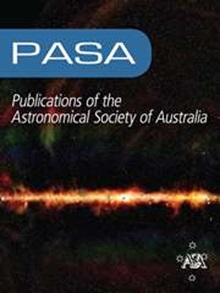n体模拟中银河系可居住性的动力学方面
IF 4.6
3区 物理与天体物理
Q1 ASTRONOMY & ASTROPHYSICS
Publications of the Astronomical Society of Australia
Pub Date : 2023-11-06
DOI:10.1017/pasa.2023.54
引用次数: 0
摘要
最近对星系演化的研究表明,恒星成分的动力学可能是考虑星系宜居性的关键因素之一。我们运行了一个银河系的n体模拟模型,我们对其进行了10 Gyr的演化,以研究恒星轨道的长期演化以及由此产生的星系可居住性相关属性,即恒星成分的密度和近距离恒星相遇。结果表明,即使在具有轻度动态加热水平的简单轴对称模型中,径向迁移也是不可忽略的,并且恒星成分的净向外扩散可以使星系外围充满可居住系统。即使在亚太阳星系中心半径处,也可能存在宜居环境,因为近距离接触的频率不应显著降低宜居性。从非圆形轨道演变成稳定的近圆形轨道的恒星通常会向外迁移,在广阔的太阳附近定居下来。R≈3 kpc和R≈12 kpc之间的区域代表了径向混合区,它可以模糊银河系宜居带的边界,就像传统理解的那样。今天太阳附近稳定的恒星数量起源于这个径向混合带,大多数恒星来自内部区域。太阳系可以被认为是一个典型的银河系宜居系统,因为它从盘内富含金属的区域向外迁移,并且在现在的时代有一个圆形的轨道。我们得出的结论是,由于恒星迁移和恒星轨道的长期演化造成的混合,银河系宜居带的边界在给定的时代不可能被严格限制。本文章由计算机程序翻译,如有差异,请以英文原文为准。
Dynamical aspects of Galactic habitability in N-body simulations
Abstract Recent studies of Galactic evolution revealed that the dynamics of the stellar component might be one of the key factors when considering galactic habitability. We run an N-body simulation model of the Milky Way, which we evolve for 10 Gyr, to study the secular evolution of stellar orbits and the resulting galactic habitability-related properties, i.e., the density of the stellar component and close stellar encounters. The results indicate that radial migrations are not negligible, even in a simple axisymmetric model with mild levels of dynamical heating, and that the net outward diffusion of the stellar component can populate galactic outskirts with habitable systems. Habitable environment is also likely even at sub-Solar galactocentric radii, because the rate of close encounters should not significantly degrade habitability. Stars that evolve from non-circular to stable nearly-circular orbits typically migrate outwards, settling down in a broad Solar neighborhood. The region between R ≈ 3 kpc and R ≈ 12 kpc represents the zone of radial mixing, which can blur the boundaries of the Galactic Habitable Zone, as it has been conventionally understood. The present-day stable population of the stars in the Solar neighborhood originates from this radial mixing zone, with most of the stars coming from the inner regions. The Solar system can be considered as a typical Milky Way habitable system because it migrated outwards from the metal-rich inner regions of the Disk and has a circular orbit in the present epoch. We conclude that the boundaries of the Galactic Habitable Zone cannot be sharply confined for a given epoch because of the mixing caused by the stellar migrations and secular evolution of stellar orbits.
求助全文
通过发布文献求助,成功后即可免费获取论文全文。
去求助
来源期刊
CiteScore
5.90
自引率
9.50%
发文量
41
审稿时长
>12 weeks
期刊介绍:
Publications of the Astronomical Society of Australia (PASA) publishes new and significant research in astronomy and astrophysics. PASA covers a wide range of topics within astronomy, including multi-wavelength observations, theoretical modelling, computational astronomy and visualisation. PASA also maintains its heritage of publishing results on southern hemisphere astronomy and on astronomy with Australian facilities.
PASA publishes research papers, review papers and special series on topical issues, making use of expert international reviewers and an experienced Editorial Board. As an electronic-only journal, PASA publishes paper by paper, ensuring a rapid publication rate. There are no page charges. PASA''s Editorial Board approve a certain number of papers per year to be published Open Access without a publication fee.

 求助内容:
求助内容: 应助结果提醒方式:
应助结果提醒方式:


